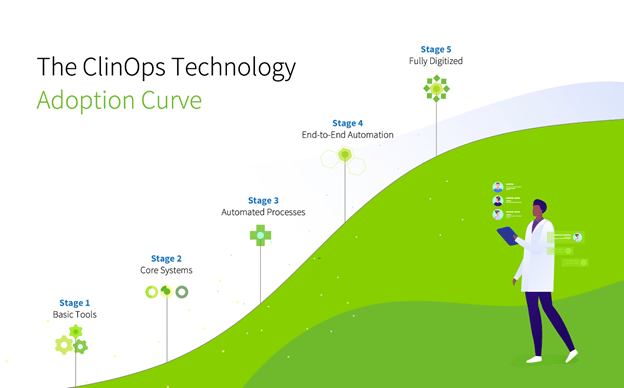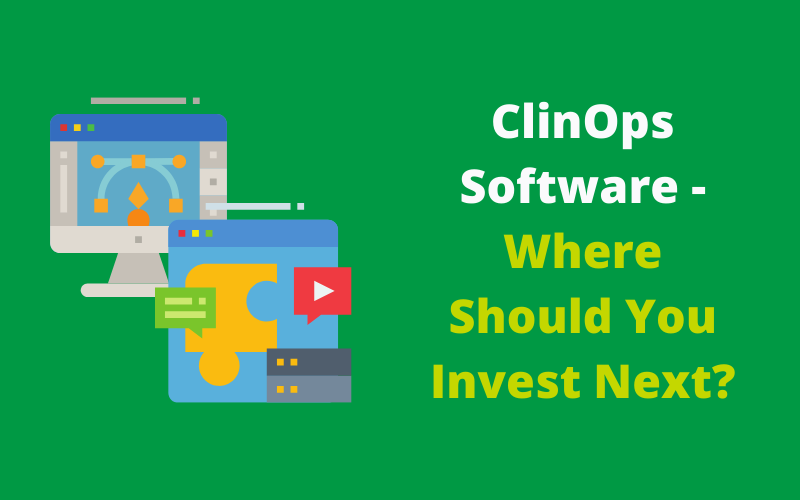CliniOps leaders: Here is the question I want to focus on today. What is the next most important clinops software application you need to incorporate into your business?
It is an important question because the right investment might allow you to overcome a critical constraint, save you a lot of money, or ensure that you pass an upcoming audit or inspection. And the wrong choice could waste time and money and hurt your position in your organization. So it is a pretty important question.
Plenty of ClinOps Software Possibilities
Every software vendor is sure it knows the answer, of course. It is their software solution. Their solution is the key to unlocking those benefits, saving that money, addressing that regulatory compliance gap. So you cannot trust the vendors of the product to be unbiased.
The good news is that I know the answer. No, I really do. Ready for it? The answer to the question “What is the next investment you should make” is… “it depends.”
I know, not very useful. Sorry. I am not trying to be a wise guy; it really does depend. It depends on a range of factors, such as the type of organization you run, the type of trials you manage, and your plans and goals for the organization.
Analyzing the ClinOps Software Adoption Curve
Analyzing software investment alternatives for ClinOps teams is my current research focus. I have a fancy MBA from a fancy school, so I have to put it to use. My goal is to create a set of tools and a process for gauging and measuring the value of clinical operations software investments.
Because just because the answer to the next software investment you should make is “it depends” does not mean we cannot have a set of tools to analyze the question and form a hypothesis about the answer. And right now, I want to introduce one tool in that analysis, which I call the “ClinOps Technology Adoption Curve.” It is a five-stage model that describes the typical steps that ClinOps organizations evolve through as they adopt technology.

Here is a graphic that illustrates the CinOps Technology Adoption Curve concept. By itself, the technology adoption curve will NOT answer the question of the right next software investment for you. But it might get you partway there. The process starts with identifying where you are today on the curve. Once you know that, you will have a good idea of where the focus of your next investments should be.
Here is an example. If you are a Stage 1 organization, your use of software is based on basic tools like spreadsheets, email, and shared folders like Dropbox. And if that is the case, your focus should be on compliance with regulatory requirements. Because with these tools, you are not addressing essential requirements and are probably vulnerable to an inspection, an audit, or a problematic submission.
On the other hand, if you are at Stage 3, you have automated your basic processes. You now need to invest in integrating systems to achieve greater process control, efficiency, and quality.
So the process begins with figuring out where you are on the curve. Here is a crib sheet (is that still a thing? Excuse showing my age).
- Stage 1 is characterized by manual, paper-based, and spreadsheet-based processes. The big issue to be addressed is compliance.
- Stage 2 organizations have fundamental applications in place: CTMS, EDC, TMF… The focus in this stage is on compliant storage and tracking.
Stage 3 organizations have shifted to automating individual processes. In this stage, the goal is to scale processes without losing control. - Stage 4 organizations are seeking to connect processes between systems to reduce manual labor. An example here is implementing site-based automation.
- Stage 5 focuses on moving beyond quality and automation to collaboration, connecting the broader group of stakeholders in soft processes.
Putting the Adoption Curve Assessment in Action
This only starts the process of deciding where to invest because if you are at Stage 1, you still don’t know whether to invest in a CTMS, an EDC, or an eTMF (or an XYZ…you get the idea). That answer requires answering more questions to illuminate where you are experiencing constraints or challenges and what you are trying to achieve next year.
In my work with my early collaborators, I have been developing a full set of questions to guide those answers. The result is an interview guide that can get you to the next step, a “Gap Analysis” to identify the key steps required to move your organization from its current state to its future state. That will reduce the choices to just a couple of possible investments or none at all.
And then the last step, finalizing the choice and selecting which tool from which vendor can be done with a simple ROI analysis. Easy peasy.
Soon, I will pull all this together into an eBook of some sort and share it with anyone interested. Until then, keep the faith… because #ClinOpsRocks.
For now, watch the replay of my webinar on the topic:
